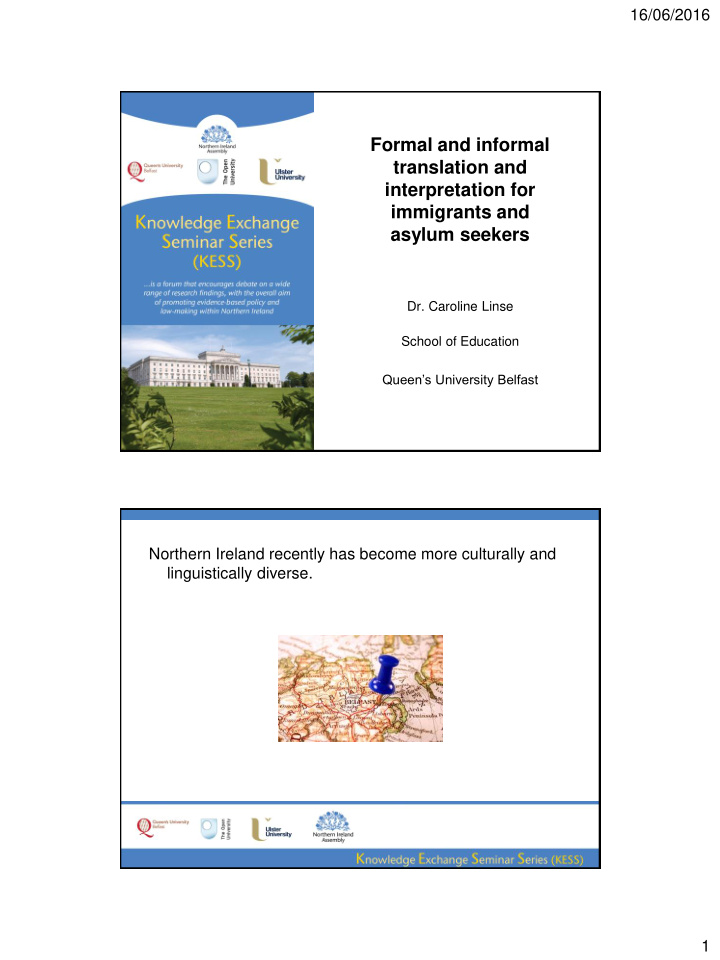



16/06/2016 Formal and informal translation and interpretation for immigrants and asylum seekers Dr. Caroline Linse School of Education Queen’s University Belfast Northern Ireland recently has become more culturally and linguistically diverse. 1
16/06/2016 Northern Ireland - Prior to Good Friday Agreement During the "Troubles." Northern Ireland was not a sought after destination for international individuals and immigrants. Northern Ireland has become a new destination since the Good Friday agreement. Newcomer Population- In 2004-2005 there were just over 2,000 newcomer learners In 2014-2015 the newcomer population rose to 11,565 learners. 2
16/06/2016 Newcomers have arrived in Northern Ireland. Newcomer learners are learners who do not possess enough English to learn through the medium of English without specialized support. Objectives To define- Linguistic capital, linguistic diversity, linguistic equality, linguistic equity, linguistic discrimination, language barrier, home school communication To describe the research To present the findings To make recommendations for different agencies serving linguistically diverse individuals 3
16/06/2016 Linguistic capital refers to the linguistic knowledge that you possess – the languages you speak. Linguistic Diversity Linguistic diversity refers to individuals who possess linguistic capital in a variety of home languages. 4
16/06/2016 Linguistic diversity can be especially difficult to address because of the formidable but not insurmountable barriers that exist when individuals cannot communicate with one another via the same language. Language Barrier – when individuals do not have a common language or means to communicate. 5
16/06/2016 Linguistic Equality is impossible to achieve since there are not sufficient resources to provide access to every document, interaction in every language. Linguistic Equity requires all individuals who speak different languages be treated with respect and consideration of their linguistic rights. 6
16/06/2016 Linguistic discrimination occurs when someone is discriminated against because they do not possess linguistic skills in a specific language – often English. (Still acceptable- Don’t speak English yet!?!?) Home school communication- Collaboration between schools and families benefits children. 7
16/06/2016 Research – Sponsored by the Inclusion and Diversity Service . and conducted with Dr. Oscar Bladas Marti What are the best ways to connect newcomer families with schools? What role does translation and interpretation play? Methodology Face to face semi-structured interviews were conducted with 30 newcomer parents and 58 school staff in Northern Ireland. Participants were asked what advice they would give schools and newcomer families to establish and improve home school communications with linguistically diverse families. 8
16/06/2016 Innovative Methodology 1 The research methodology addressed the cultural and linguistic diversity of participants by editing the research instruments based on principles of second language acquisition. The instruments were edited (with the help of the Inclusion and Diversity Service) so that they could easily be translated into other languages and also be understood by individuals with mixed levels of English language proficiency. What are your plans for half term? What are your plans for the October holidays or school vacation? What are your intentions with regards to residing in Northern Ireland? How long will you stay in Northern Ireland? What brought you to Northern Ireland? Why did you come to Northern Ireland? 9
16/06/2016 Research with Linguistically Diverse Participants Two types of professionals were utilized as translators and interpreters. Bilingual school staff who possess a sufficient amount of contextual knowledge and are able to effectively translate and interpret. The second group are professionally certified interpreters. Research with Linguistically Diverse Participants The interview guide was piloted with fully proficient bilingual participants, representing a variety of cultures, in an effort to make sure that the instrument was valid across cultures without having to be mediated through an interpreter or translator. 10
16/06/2016 Findings- Translation and interpretation was key. It was embedded in an ethos of linguistic equity. Respect and accommodation for linguistic diversity emerged as the major overarching theme. The manner in which translation is offered is paramount. “Not a language problem.” 11
16/06/2016 The schools acknowledged and respected linguistic diversity. -expressed empathy for language skills “I wish my Spanish was a fraction as good as their English.” Schools posted signs in learners' home languages -information and acknowledgement of diversity 12
16/06/2016 Schools prepared welcome books specifically for culturally and linguistically diverse families – written in plain English Names – roles of staff members Events – routines Schedules- Calendar Both formal and informal translation and interpretation were utilized by families. . School staff member- Parent- Interpreter / translator 13
16/06/2016 Informal translation and interpretation- Friends, neighbors, work colleagues, sons, daughters, served as interpreters- Informal translation can be convenient but there are problems- Lack of specific content specific knowledge Lack of adherence to confidentiality Formal Interpretation- Professional Translators- Advantages- Can translate content accurately even if they do not have specific content experience Adhere to confidentiality agreements Bilingual School Staff – know specific content – adhere to confidentiality requirements – can create a positive ongoing relationship between home and school In some cases a dedicated phone line is available Fully Qualified Translators / Interpreters-\Disadvantages - They are not always available for all languages 14
16/06/2016 Recommendations- Listed below are a set of recommendations for agencies wishing to connect with culturally and linguistically diverse families. Promote a spirit of linguistic equity. Provide linguistic equality training for all members of staff both professional and administrative. Review all documentation to ensure that clear straightforward language is used. Simple sentence structures and simple clear vocabulary should be used. Whenever appropriate hire bilingual staff with the requisite professional background and training. Use fully certified and licensed translators and interpreters. 15
16/06/2016 16
Recommend
More recommend